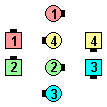A Diamond is a 4-dancer formation that can be setup from a Line of 4 after Centers Hinge.
A Diamond consists of two Centers (those with handholds), and two Ends (also known as Points).
Diamond Circulate [Plus] (Dewey Berry 1972):
From a Diamond.
Walk forward to the next position in the Diamond while turning 90° toward the center of the Diamond.
Centers become Points and vice-versa. Dancers facing along the Circulate path pass Right-Shoulders with each other.
Diamonds typically occur in pairs.
- Twin Diamonds are adjacent along the short axis.
- Point-to-Point Diamonds are adjacent along the long axis.

| | Twin Diamonds |
|

| | Point-to-Point Diamonds |
|
Notes:
-
If you are a Center of the Diamond, hold hands with the other center in your Diamond.
-
If you are a Point, use your inside hand to point downward toward the center
of your Diamond. Do not touch hands with anyone in your Diamond.
-
The handhold or lack thereof is important because most Diamond calls are defined
in terms of Points and Centers. That is, Points do this, and Centers do that.
If your hand location is incorrect, it may cause confusion as to who does
which part.
At Plus, there are three calls done exclusively from Diamonds:
- Diamond Circulate [Plus] (Dewey Berry 1972):
From a Diamond.
Walk forward to the next position in the Diamond while turning 90° toward the center of the Diamond.
Centers become Points and vice-versa. Dancers facing along the Circulate path pass Right-Shoulders with each other.
- Flip The Diamond [Plus] (Deuce Williams 1973):
From a Diamond. Centers do your part Diamond Circulate as Points Flip In (180°) towards the the nearest Center position. A normal Diamond ends in a Wave.
- Cut The Diamond [Plus] (Lee Kopman 1973):
From a Diamond.
Centers do your part Diamond Circulate as
Points slide together and Trade
to end in the furthest Center position.
A normal Diamond ends in a Two-Faced Line.
The Diamond formation can have a different name, depending upon facing direction of the outside dancers:

| | Single 1/4 Tag Formation |
|

| | Single 3/4 Tag Formation |
|
There is a subtle difference between the footprints of Twin Diamonds and a Generalized 1/4 Tag Formation.

| | Twin Diamonds |
|

| | Generalized 1/4 Tag Formation |
|
|
The exact position of the Outside dancers is dependent upon their facing direction.
For Twin Diamonds, the outsides are equidistant between the centers on their side; whereas
for a Generalized 1/4 Tag, the outsides are immediately adjacent (holding hands).
While dancing, the formation can shift between these two formations. |
A Diamond formation is contained within a 2 x 3 matrix.
A Diamond is 2-spots in width, and 3-spots in length.
|
2 x 3 Matrix:

| RIGHT
(length = 3 spots) |
|
2 x 4 Matrix:

| WRONG
(length = 4 spots) |
|
Square Breathing is a term used to indicate that dancer positions
dynamically change as formations expand and contract.
See example below:

| This is the starting formation
for each of the following: | | |

| |

| after
Centers Hinge WRONG
(without Square Breathing)
Outsides did not adjust | | after
Centers Hinge RIGHT
(with Square Breathing)
Outsides moved 1/2 position inward
and 1/2 position forward or backward
to form perfect Diamonds |
|
Drop direction [C2] (Lee Kopman 1975):
From a Diamond or Generalized Single 1/4 Tag with the Centers in a Mini-Wave.
Centers do your part of Extend the Tag as the Others 1/4 toward the given direction
(relative to the 4-dancer formation).
Adjust to end in a 2 x 2.